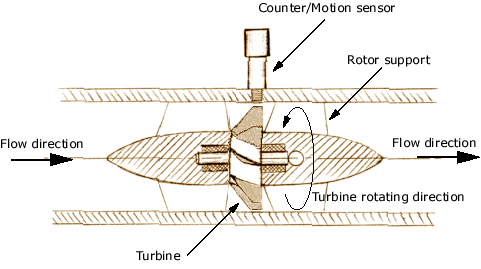
The turbine flow meter (better described as an axial turbine) translates the mechanical action of the turbine rotating in the liquid flow around an axis into a user-readable rate of flow (gpm, lpm, etc.). The turbine tends to have all the flow traveling around it.
The turbine wheel is set in the path of a fluid stream. The flowing fluid impinges on the turbine blades, imparting a force to the blade surface and setting the rotor in motion. When a steady rotation speed has been reached, the speed is proportional to fluid velocity.
Turbine flow meters are used for the measurement of natural gas and liquid flow. Turbine meters are less accurate than displacement and jet meters at low flow rates, but the measuring element does not occupy or severely restrict the entire path of flow. The flow direction is generally straight through the meter, allowing for higher flow rates and less pressure loss than displacement-type meters. They are the meter of choice for large commercial users, fire protection, and as master meters for the water distribution system. Strainers are generally required to be installed in front of the meter to protect the measuring element from gravel or other debris that could enter the water distribution system. Turbine meters are generally available for 1-1/2" to 12" or higher pipe sizes. Turbine meter bodies are commonly made of bronze, cast Iron, or ductile iron. Internal turbine elements can be plastic or non-corrosive metal alloys. they are accurate in normal working conditions to 0.2l/s however are affected greatly with dog mix interference.
Fire meters are a specialized type of turbine meter with approvals for the high flow rates required in fire protection systems. They are often approved by Underwriters Laboratories (UL) or Factory Mutual (FM) or similar authorities for use in fire protection. Portable turbine meters may be temporarily installed to measure water used from a fire hydrant. The meters are normally made of aluminum to be light weight, and are usually 3" capacity. Water utilities often require them for measurement of water used in construction, pool filling, or where a permanent meter is not yet installed.
Typical Applications for turbine flow meters
- Pilot plants
- Research and development facilities
- Cooling water monitoring
- Inventory control metering applications
- Test stands
- Water consumption
- Makeup water
- High accuracy and good repeatability
- Fast response timetypically a few milliseconds
- Wide flow range options for both liquids and gases
- Good flexibility with associated digital readout devices including flow control options for both PC and PLC's
- Require upstream straightener and filter for best results
- May over-read in pulsating flows
- Turbine flow meters for liquid can require regular re-calibration due to bearing wear
- Particulates can cause line blockage

